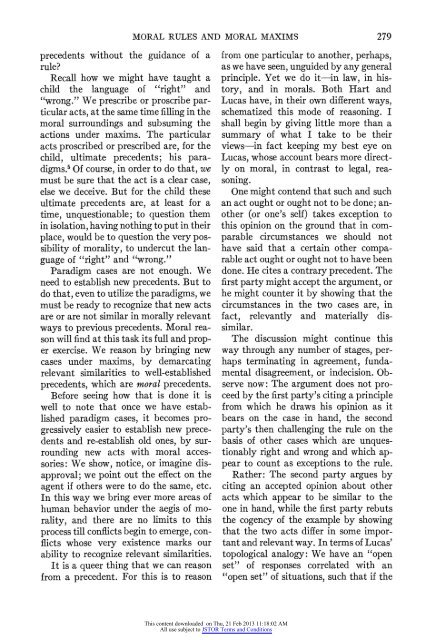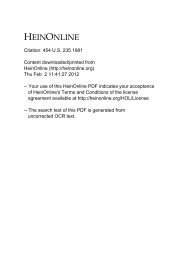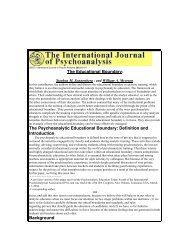Moral Rules and Moral Maxims - The University of Texas at Austin
Moral Rules and Moral Maxims - The University of Texas at Austin
Moral Rules and Moral Maxims - The University of Texas at Austin
Create successful ePaper yourself
Turn your PDF publications into a flip-book with our unique Google optimized e-Paper software.
precedents without the guidance <strong>of</strong> arule?Recall how we might have taught achild the language <strong>of</strong> "right" <strong>and</strong>"wrong." We prescribe or proscribe particularacts, <strong>at</strong> the same time filling in themoral surroundings <strong>and</strong> subsuming theactions under maxims. <strong>The</strong> particularacts proscribed or prescribed are, for thechild, ultim<strong>at</strong>e precedents; his paradigms.5Of course, in order to do th<strong>at</strong>, wemust be sure th<strong>at</strong> the act is a clear case,else we deceive. But for the child theseultim<strong>at</strong>e precedents are, <strong>at</strong> least for <strong>at</strong>ime, unquestionable; to question themin isol<strong>at</strong>ion, having nothing to put in theirplace, would be to question the very possibility<strong>of</strong> morality, to undercut the language<strong>of</strong> "right" <strong>and</strong> "wrong."Paradigm cases are not enough. Weneed to establish new precedents. But todo th<strong>at</strong>, even to utilize the paradigms, wemust be ready to recognize th<strong>at</strong> new actsare or are not similar in morally relevantways to previous precedents. <strong>Moral</strong> reasonwill find <strong>at</strong> this task its full <strong>and</strong> properexercise. We reason by bringing newcases under maxims, by demarc<strong>at</strong>ingrelevant similarities to well-establishedprecedents, which are moral precedents.Before seeing how th<strong>at</strong> is done it iswell to note th<strong>at</strong> once we have establishedparadigm cases, it becomes progressivelyeasier to establish new precedents<strong>and</strong> re-establish old ones, by surroundingnew acts with moral accessories:We show, notice, or imagine disapproval;we point out the effect on theagent if others were to do the same, etc.In this way we bring ever more areas <strong>of</strong>human behavior under the aegis <strong>of</strong> morality,<strong>and</strong> there are no limits to thisprocess till conflicts begin to emerge, conflictswhose very existence marks ourability to recognize relevant similarities.It is a queer thing th<strong>at</strong> we can reasonfrom a precedent. For this is to reasonMORAL RULES AND MORAL MAXIMS 279from one particular to another, perhaps,as we have seen, unguided by any generalprinciple. Yet we do it-in law, in history,<strong>and</strong> in morals. Both Hart <strong>and</strong>Lucas have, in their own different ways,schem<strong>at</strong>ized this mode <strong>of</strong> reasoning. Ishall begin by giving little more than asummary <strong>of</strong> wh<strong>at</strong> I take to be theirviews-in fact keeping my best eye onLucas, whose account bears more directlyon moral, in contrast to legal, reasoning.One might contend th<strong>at</strong> such <strong>and</strong> suchan act ought or ought not to be done; another(or one's self) takes exception tothis opinion on the ground th<strong>at</strong> in comparablecircumstances we should nothave said th<strong>at</strong> a certain other comparableact ought or ought not to have beendone. He cites a contrary precedent. <strong>The</strong>first party might accept the argument, orhe might counter it by showing th<strong>at</strong> thecircumstances in the two cases are, infact, relevantly <strong>and</strong> m<strong>at</strong>erially dissimilar.<strong>The</strong> discussion might continue thisway through any number <strong>of</strong> stages, perhapstermin<strong>at</strong>ing in agreement, fundamentaldisagreement, or indecision. Observenow: <strong>The</strong> argument does not proceedby the first party's citing a principlefrom which he draws his opinion as itbears on the case in h<strong>and</strong>, the secondparty's then challenging the rule on thebasis <strong>of</strong> other cases which are unquestionablyright <strong>and</strong> wrong <strong>and</strong> which appearto count as exceptions to the rule.R<strong>at</strong>her: <strong>The</strong> second party argues byciting an accepted opinion about otheracts which appear to be similar to theone in h<strong>and</strong>, while the first party rebutsthe cogency <strong>of</strong> the example by showingth<strong>at</strong> the two acts differ in some important<strong>and</strong> relevant way. In terms <strong>of</strong> Lucas'topological analogy: We have an "openset" <strong>of</strong> responses correl<strong>at</strong>ed with an"open set" <strong>of</strong> situ<strong>at</strong>ions, such th<strong>at</strong> if theThis content downloaded on Thu, 21 Feb 2013 11:18:02 AMAll use subject to JSTOR Terms <strong>and</strong> Conditions
















